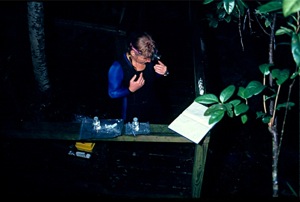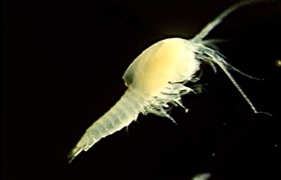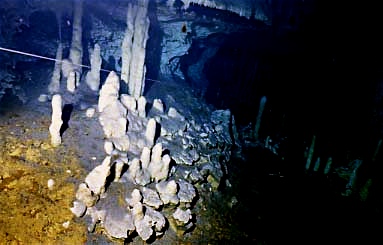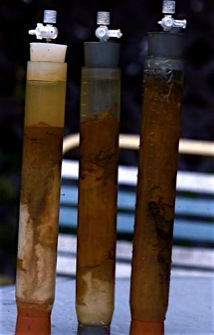
Newly identified life from the Black Hole of South Andros
New Species of Bacteria discovered from the Black Hole of South Andros:
It has taken two years, countless hours by multinationals to identify and isolate this tiny living life form but finally it has yielded its secret to the scientific world. This new discovery named after the late Robert John Palmer (5) (6) who was the first person to describe the black hole in his book, 'The Blue Holes of the Bahamas.’ This is a very unusual bacterium in that it seems to be responsible for most of the unusual heat being generated in the one metre thick layer found at 17.8 metres at this site.
It is theorized that these vertical cave systems are very much formed by microbial activity, from the surface down. These do not appear to be the classic collapse features of Mexico because they are bowl shaped underwater and there never seemed to be any geological buildup of rocks on this part of the island. We see baby black holes, if you will, and they certainly support the idea that these features are forming from the surface down. For further explanation on how we think these caves formed please refer to the paper.
Currently the foundation is working with Mark Ohman at Scripps Institute of Oceanography who has a specialty in working with copepods. The Foundation has provided him with samples from the Black Hole and it appears that we can be hopeful for possibly a few new species. Its looking good!


Allocromatium palmerii, one of the new species of bacteria purple bacteria discovered in the microbial layer in the Black Hole.

Example of a copepod found in a cave on South Andros Island, The Bahamas. They live within the water column and can be caught in plankton nets.
San Salvador Island and Grand Bahama, The Bahamas
The blood rains....but a life line for bacteria


What we are talking about here is the Saharan dust that is blown into the atmosphere from North Africa and is distributed all over the Caribbean, The Bahamas, and in North America, from Texas to Maine. We actually do not call them, ‘Blood Rains,’ in the Bahamas but if there was a large dust storm and rain, we probably could.
They do in the Canary Islands that are located right off the west coast of North Africa. During a dust storm event, should it rain over the Canary Island, the rain is red, hence, ‘Blood Rain.’ In actuality, these rain should be called the rains of life, not so much because so many areas need the fresh water but because of the dust. In areas like the Bahamas where the islands are composed mostly of limestone and nothing else, everything that grows there from vegetation to bacteria, all would most likely not live well if it were not for the macro and micro nutrients that arrive in winds. These nutrients are metals, most of which when we see what they are would hold our breath (1). It is also very likely that the dust helps support life in the Amazon, especially since the soils are so poor there. However, our ocean life, especially algae and
bacteria most likely depend on the African atmospheric deliveries. As you can see from the cores above, the iron oxide dust is distinct. It is also seen clearly on the cave floor in the next photo up. It actually forms mud cracks, a very confusing observation when one is floating in water. XRD analysis identifies this material as iron oxides, basically rust. In the film, Mermaid’s Lair, I pick up some of this material. One correction I would like to make in my narrations during this film is that I thought at the time that the material came into the cave when it was dry. I believe that the correct answer is that it arrives mostly by water. Tidal water carried the material into the cave where the water flow is slow enough to allow this very fine material to settle out on the cave floor. It is known from earlier Ocean Drilling Projects (ODP) that there is an enormous collection of this dust on the floor of the Atlantic, so why not the caves? Research is continuing on the influence of this dust on the islands.
Holocene Saharan Dust results!

EnviroMatrix Analytical, Inc, located in San Diego California have been very generous in sponsoring the RPBHF over the past years in covering the cost of analyzing many soil and rock samples collected from the Bahamas. The most recent samples have provided some very astounding results. No doubt, they are rusty. The samples contained on average 68.2 g of iron oxide. That certainly explains why these samples are almost blood red. They also carry a significant amount of arsenic (As). Aside from As, eleven other metals were detected. Earlier experimental work revealed that a host of bacteria make the trip across the ocean on the dust, potentially providing an explanation to the elevated cases of upper respiratory aliments in children in the Caribbean during dust storm events.
Now with so many results from samples that range in age from more than 400,000 years to current time, we now are able to examine changes in composition of the dust over time. What we have found is that the carbonate rock that makes up the islands of the Bahamas are virtually void of any of these trace minerals suggesting potentially that something else is happening with the materials. It is possible that the changes we see in the composition of the dust could be explained by microbial, algal and or vegetation uptake. The dust contains all the micronutrients that are needed by most bacteria, something that the host rock does not supply. If it turns out that this dust dictates the success of microbial growth, certainly within the carbonate environment, this will be a big piece of the biogenic story in the formation of caves or very large holes in rocks.